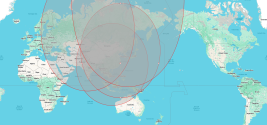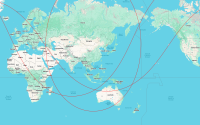This is what I would expect to happen in a blue-water battle where there is limited support from land-based aircraft and missiles.
1. Air battle(s) with Six squadrons versus Two squadrons. This occurs beyond the range of ship-based SAMs eg. 300km range HHQ-9
2. The side with the smaller naval aviation force gets wiped out
3. The winning side destroys any opposing ISR aircraft
4. The winning side uses its ISR aircraft to detect ships at a range of 400km.
5. Antiship missiles are launched at the ships from 400km+ away. It doesn't matter what the launch platform is, nor what type(s) of antiship missile.
6. The defending ships get hit or eventually run out of SAMs. Then they get wiped out.
Comments?
---
Hence my view that there is no alternative but for the Chinese Navy to field a significantly larger fleet of aircraft carriers and naval aviation.
At that point, we could expect the Chinese Navy to be capable of dealing a catastrophic defeat against an opposing naval force.
But realistically, it will take at least a decade to build such a fleet.
Your first premise is already outdated and completely wrong way to fight in the modern era. Why should a Chinese fleet with only 1 carrier send its 2 squadrons to fight all the way out of the safety of its ship-based air defense zone, where it has the least advantage and no chance of winning.
Deep sea Naval battle can happen in 2 ways, either offense or defense. If you find the enemy ships first and decide to attack the fleet to sink it, that is offense. If you are being attacked that is defense.
First of all, if you are the defender, your biggest advantage is the ship based SAM systems, creating a dense bubble that enemy planes cannot enter without getting shot down. A chinese fleet with 20 destroyers and 20 frigates will create a very well dispersed and dense layered air and missile defense network that no enemy can penetrate.
Chinese carrier planes should not get out of that bubble and become vulnerable. They should take advantage of that bubble.
So, the best way for China to defend will be to use its carrier based planes, both AWACS and fighters as observers and scouts. They should focus on spotting the attacker early and guide its ship based SAMs towards the enemy planes and incoming missiles. They have the advantage of flying high and looking down and spotting low flying planes and missiles. Once those missiles and planes are detected and comes within range of the SAMs, they are toast. The carrier based planes will also provide backup with their AA missiles, but again well within the SAM bubble and thus safe from enemy planes.
Now when it comes to offense, again, the focus of carrier aviation should be spotting the enemy ships if satellite based detection do not work. Once the enemy fleet is found, Chinese ship based anti-ship missiles should have enough range to fire at them. Which again means, Chinese planes do not have to be the attacker on the enemy fleet.
Carrier based planes can carry more anti-ship missiles since missiles are usually smaller and subsonic, but those missiles are also weak and easier to shoot down. I would say its much better to attack enemy fleet with ship based hypersonic and high supersonic anti-ship missiles.
Here is my concluding point responding to your comment. I think Carriers are getting extremely vulnerable and could become totally defenseless if hypersonic missile tech keeps getting better. With satellite based tracking getting good, they cannot hide at all, and thus all the enemy has to do is fire long range ASBM at them.
The only saving grace carriers have is the fact the carrier-based planes provide over the horizon radar capability and long range scouting. But even that could be too costly over the long term.
Distributed lethality is the way to go and carriers are not it. China's focus on more destroyers and frigates is the better option and they don't need that many carriers.
If China gets for example 10 carriers, then they should get 160 destroyers and 160 frigates. This is a much better ratio compared to US with 10 carriers but just 80 destroyers and no frigates.


